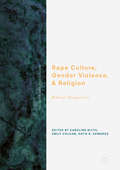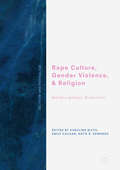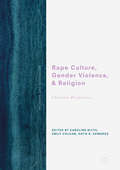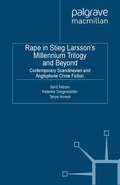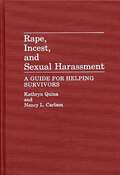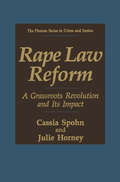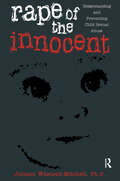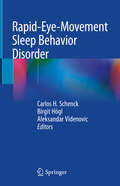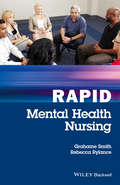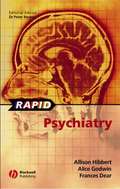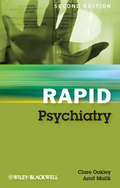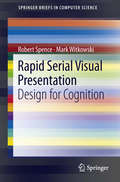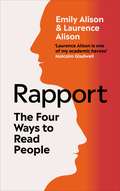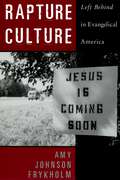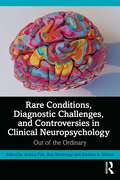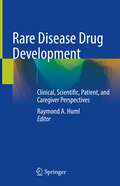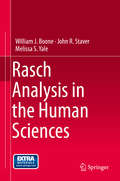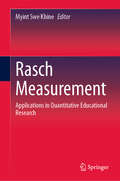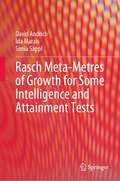- Table View
- List View
Rape Culture, Gender Violence, and Religion: Biblical Perspectives (Religion and Radicalism)
by Caroline Blyth Emily Colgan Katie B. EdwardsThis book explores the Bible’s ongoing relevance in contemporary discussions around rape culture and gender violence. Each chapter considers the ways that biblical texts and themes engage with various forms of gender violence, including the subjective, physical violence of rape, the symbolic violence of misogynistic and heteronormative discourses, and the structural violence of patriarchal power systems. The authors within this volume attempt to name (and shame) the multiple forms of gender violence present within the biblical traditions, contesting the erasure of this violence within both the biblical texts themselves and their interpretive traditions. They also consider the complex connections between biblical gender violence and the perpetuation and validation of rape culture in contemporary popular culture. This volume invites new and ongoing conversations about the Bible’s complicity in rape-supportive cultures and practices, challenging readers to read these texts in light of the global crisis of gender violence.
Rape Culture, Gender Violence, and Religion: Biblical Perspectives (Religion And Radicalism Ser.)
by Caroline Blyth Emily Colgan Katie B. EdwardsReligion And Radicalism Ser.
Rape Culture, Gender Violence, and Religion: Christian Perspectives (Religion and Radicalism)
by Caroline Blyth Emily Colgan Katie B. EdwardsThis volume considers the complex relationships that exist between Christianity, rape culture, and gender violence. Each chapter explores the various roles that Christian theologies, teachings, and practices have played in shaping contemporary understandings of gender violence and in sanctioning rape-supportive cultural belief systems and practices. Our contributors explore this topic from a range of disciplinary perspectives, including theology, gender and queer studies, cultural studies, pastoral care, and counseling. Together, the chapters in this volume testify to the considerable influence that Christianity has had, and continues to have, in directing conversations within the Christian tradition around gender violence and rape culture. They therefore invite readers to engage fruitfully in these conversations, fostering transformative dialogues with the Christian community about our shared responsibility to tackle the current global crisis of gender violence.
Rape Culture, Gender Violence, and Religion: Christian Perspectives (Religion and Radicalism)
by Caroline Blyth Emily Colgan Katie B. EdwardsThis volume considers the complex relationships that exist between Christianity, rape culture, and gender violence. Each chapter explores the various roles that Christian theologies, teachings, and practices have played in shaping contemporary understandings of gender violence and in sanctioning rape-supportive cultural belief systems and practices. Our contributors explore this topic from a range of disciplinary perspectives, including theology, gender and queer studies, cultural studies, pastoral care, and counseling. Together, the chapters in this volume testify to the considerable influence that Christianity has had, and continues to have, in directing conversations within the Christian tradition around gender violence and rape culture. They therefore invite readers to engage fruitfully in these conversations, fostering transformative dialogues with the Christian community about our shared responsibility to tackle the current global crisis of gender violence.
Rape in Stieg Larsson's Millennium Trilogy and Beyond: Contemporary Scandinavian and Anglophone Crime Fiction
by Berit Åström Katarina Gregersdotter Tanya HoreckFocusing on the sexualized violence of Stieg Larsson's bestselling Millennium trilogy – including the novels, Swedish film adaptations, and Hollywood blockbusters – this collection of essays puts Larsson's work into dialogue with Scandinavian and Anglophone crime novels by writers including Jo Nesbø, Håkan Nesser, Mo Hayder and Val McDermid.
Rape, Incest, and Sexual Harassment: A Guide for Helping Survivors
by Nancy L. Carlson Kathryn QuinaA working guide to the treatment of survivors of sexual victimization, this book treats rape, incest, and harassment as related forms of sexual abuse. It reviews present literature on the long-term effects of sexual assault and considers the services and support that survivors require. Covering a wide range of issues and treatment approaches, focus is placed on the older adolescent and adult. The phases of recovery followng sexual abuse are described together with the type of assistance most appropriate at each phase. The authors provide numerous case studies and emphasize the individuality of both survivor and response. This guide should be used by both professional and layperson to help the sexually abused transcend feelings of victimization.Rape, Incest, and Sexual Harassment discusses the issues raised by victimization. It then deals with the immediate aftermath of sexual abuse focusing on crisis intervention and advocacy with respect to emotional, medical, and legal needs. One section, devoted to counselors working with long-term effects on survivors, matches interventions to the individual client's needs and offers models for counseling frameworks. Special needs are also addressed. The book concludes with a look at the larger social problems associated with abuse and violence.
Rape Law Reform: A Grassroots Revolution and Its Impact (The Plenum Series in Crime and Justice)
by Cassia Spohn Julie HorneyThis book evolved from our interest in rape as feminists and as sodal sdentists. As feminists, we were concemed about the treatment of rape victims and the attrition in rape cases under traditional rape law, and we welcomed legal reforms designed to improve the situation. As sodal sdentists, we wondered about the efficacy of legal changes aimed at an inherently resistant court system. We also were curious about the lack of studies examining the impact of these changes; we were particularly surprised to find that no one had attempted to ana lyze the impact of the reforms in more than one jurisdiction. Con vinced that untangling the effects of the reforms from the effects of contextual factors required a multijurisdictional study, we deeided to undertake the project. We quickly discovered that evaluating rape law reform in several jurisdictions would be no easy task. We had deeided that such an evaluation would require monthly data on the outcome of rape cases before and after the reforms were implemented, as weIl as qualitative data on the attitudes of criminal justice officials toward the reforms. Because states do not generate monthly data on case outcomes, we would have to collect the data ourse1ves from court records main tained by individual jurisdictions. To obtain an adequate number of cases for the time-series analysis, we would have to select our sites from large urban jurisdictions scattered throughout the United States.
Rape Of The Innocent: Understanding And Preventing Child Sexual Abuse
by Juliann Whetsell MitchellWritten for mental health professionals, crisis hot line workers, educators and clergy, this resource discusses how to prevent and recognise child sexual abuse and what to do if abuse is suspected. The content covers many settings in which sexual abuse may occur, including the home, day care and group settings. A special section addresses abuse of minority children and those who are handicapped. The author has also included a glossary of terms relevant to the study and prevention of abuse.
Rape Of The Innocent: Understanding And Preventing Child Sexual Abuse
by Juliann Whetsell MitchellWritten for mental health professionals, crisis hot line workers, educators and clergy, this resource discusses how to prevent and recognise child sexual abuse and what to do if abuse is suspected. The content covers many settings in which sexual abuse may occur, including the home, day care and group settings. A special section addresses abuse of minority children and those who are handicapped. The author has also included a glossary of terms relevant to the study and prevention of abuse.
Rapid-Eye-Movement Sleep Behavior Disorder
by Carlos H. Schenck Birgit Högl Aleksandar VidenovicThis book describes a sleep disorder belonging to the category of parasomnias (i.e. the sleep behavioral and experiential disorders) characterized by abnormal vocal and motor behaviors in the context of vivid dreams and loss of the customary muscle atonia during the stage of sleep called REM sleep. REM-atonia - one of the defining features of REM sleep, along with rapid-eye-movements and a highly activated brain state - serves a protective function, preventing the dreamer from acting-out dreams and becoming injured. REM sleep behavior disorder (RBD) was first described in 1986 by Schenck and colleagues; since then the understanding of the condition has increased exponentially, also pointing out its strong association with the development of neurodegenerative disorders characterized by alpha synuclein deposition, such as Parkinson’s disease, Dementia with Lewy bodies, and Multiple System Atrophy. Furthermore, RBD is now considered one of the earliest markers of ongoing alpha synuclein neurodegeneration, and provides a window of opportunity for testing disease modifying therapies that may slow down or halt the progression of these disorders for which there is currently no cure. Additionally, RBD is today known to be present in more than 50% of patients with narcolepsy-cataplexy, and can also be triggered by the most commonly prescribed antidepressant medications (e.g. SSRIs, venlafaxine). RBD has been documented as occurring, with variable frequency, with virtually every category of neurologic disease and has also helped expand the field of dream research. The volume Editors have pioneered scientific and clinical advances in the field and, partnering with leading sleep clinicians and researchers on this book, have produced an invaluable guide to specialists in sleep medicine, neurology, psychiatry and psychology. There are also strong contributions in this book by leading basic science researchers, and so this book should also appeal to neuroscientists. As stated in the book, "RBD is situated at a strategic and busy crossroads of sleep medicine and the neurosciences. RBD offers great breadth and depth of research opportunities, including extensive inter-disciplinary and multinational research opportunities...RBD is an 'experiment of Nature' in which knowledge from the study of motor-behavioral dyscontrol during REM sleep, with dream-enactment, has cast a broad and powerful light on a multitude of Central Nervous System disturbances, their evolution, and their comorbidities."
Rapid Mental Health Nursing (Rapid)
by Grahame Smith Rebecca RylanceA concise, pocket-sized, A-Z rapid reference handbook on all the essential areas of mental health nursing, aimed at nursing students and newly qualified practitioners. Covers a broad range of mental health disorders, approaches interventions and conditions Easy to locate practical information quickly in a pocket sized, rapid reference format The topics and structure are mapped on to the NMC’s (2010) Standards for Pre-registration Nursing Education and their required essential skills and knowledge.
Rapid Mental Health Nursing (Rapid)
by Grahame Smith Rebecca RylanceA concise, pocket-sized, A-Z rapid reference handbook on all the essential areas of mental health nursing, aimed at nursing students and newly qualified practitioners. Covers a broad range of mental health disorders, approaches interventions and conditions Easy to locate practical information quickly in a pocket sized, rapid reference format The topics and structure are mapped on to the NMC’s (2010) Standards for Pre-registration Nursing Education and their required essential skills and knowledge.
Rapid Psychiatry
by Allison Hibbert Alice Godwin Frances DearRapid Psychiatry is the fifth title in the Rapid series of short revision notes books, covering key information in a simple and easily accessible format, using a mnemonic to aid recall. This book provides an excellent revision tool in the run-up to exams, but is also useful for clinical students working on Psychiatry attachments. Rapid Psychiatry covers the common psychiatric conditions encountered on the wards, in clinics, in general practice, and in exams. It acts as a rapid refresher, and is a concise no-nonsense book covering just the basic relevant facts. The book is divided into sections covering psychiatric history-taking and examination, differential diagnosis, disorders, treatment, the key points of the Mental Health Act, psychiatric emergencies, and a glossary of terms. The disorders are arranged in A-Z format, and each topic is covered using the same Rapid series mnemonic that covers Definition, Aetiology, Associations/Risk Factors, Epidemiology, History, Examination, Pathology, Investigations, Management, Complications, Prognosis and Differential Diagnosis.
Rapid Psychiatry (Rapid #19)
by Clare Oakley Amit MalikThis pocket guide is a must for all clinical medical students and junior doctors and provides an excellent revision tool in the run-up to exams. It is also perfect for when working on the psychiatric attachment, as it covers many of the conditions encountered on the wards, in clinics, and in general practice. Now thoroughly updated, it includes new sections on Neuropsychiatry, the Psychiatry of Learning Disability, Forensic Psychiatry, and Psychotherapy, as well as common disorders, their assessment and their treatment. Featuring the key points of the Mental Health Act, along with a glossary of terms, Rapid Psychiatry is the ideal refresher, covering just the basic relevant facts.
Rapid Psychiatry (Rapid #28)
by Clare Oakley Amit MalikThis pocket guide is a must for all clinical medical students and junior doctors and provides an excellent revision tool in the run-up to exams. It is also perfect for when working on the psychiatric attachment, as it covers many of the conditions encountered on the wards, in clinics, and in general practice. Now thoroughly updated, it includes new sections on Neuropsychiatry, the Psychiatry of Learning Disability, Forensic Psychiatry, and Psychotherapy, as well as common disorders, their assessment and their treatment. Featuring the key points of the Mental Health Act, along with a glossary of terms, Rapid Psychiatry is the ideal refresher, covering just the basic relevant facts.
Rapid Serial Visual Presentation: Design for Cognition (SpringerBriefs in Computer Science)
by Robert Spence Mark WitkowskiA powerful new image presentation technique has evolved over the last twenty years, and its value demonstrated through its support of many and varied common tasks. Conceptually, Rapid Serial Visual Presentation (RSVP) is basically simple, exemplified in the physical world by the rapid riffling of the pages of a book in order to locate a known image. Advances in computation and graphics processing allow RSVP to be applied flexibly and effectively to a huge variety of common tasks such as window shopping, video fast-forward and rewind, TV channel selection and product browsing. At its heart is a remarkable feature of the human visual processing system known as pre-attentive processing, one which supports the recognition of a known image within as little as one hundred milliseconds and without conscious cognitive effort.Knowledge of pre-attentive processing, together with extensive empirical evidence concerning RSVP, has allowed the authors to provide useful guidance to interaction designers wishing to explore the relevance of RSVP to an application, guidance which is supported by a variety of illustrative examples.
Rapport: The Four Ways to Read People
by Laurence Alison Emily AlisonGet what you want from even the most difficult charactersAll of us have to deal with difficult people. Whether we’re asking our neighbour to move a fence or our boss for a pay rise, we can struggle to avoid arguments and get what we want.Laurence and Emily Alison are world leaders in forensic psychology, and they specialise in the most difficult interactions imaginable: criminal interrogations. They advise and train the police, security agencies, the FBI and the CIA on how to deal with extremely dangerous suspects when the stakes are high. After 30 years’ work – and unprecedented access to 2,000 hours of terrorist interrogations – they have developed a ground-breaking model of interpersonal communication. This deceptively simple approach to handling any encounter works as well for teenagers as it does for terrorists. Now it’s time to share it with the world.Rapport reveals that every interaction follows four styles: Control (the lion), Capitulate (the mouse), Confront (the Tyrannosaur) and Co-operate (the monkey). As soon as you understand these styles and your own goals you can shape any conversation at will. And you’ll be closer to the real secret: how to create instant rapport.
Rapture Culture: Left Behind in Evangelical America
by Amy Johnson FrykholmIn the "twinkling of an eye" Jesus secretly returns to earth and gathers to him all believers. As they are taken to heaven, the world they leave behind is plunged into chaos. Cars and airplanes crash and people search in vain for loved ones. Plagues, famine, and suffering follow. The antichrist emerges to rule the world and to destroy those who oppose him. Finally, Christ comes again in glory, defeats the antichrist and reigns over the earth. This apocalyptic scenario is anticipated by millions of Americans. These millions have made the Left Behind series--novels that depict the rapture and apocalypse--perennial bestsellers, with over 40 million copies now in print. In Rapture Culture, Amy Johnson Frykholm explores this remarkable phenomenon, seeking to understand why American evangelicals find the idea of the rapture so compelling. What is the secret behind the remarkable popularity of the apocalyptic genre? One answer, she argues, is that the books provide a sense of identification and communal belonging that counters the "social atomization" that characterizes modern life. This also helps explain why they appeal to female readers, despite the deeply patriarchal worldview they promote. Tracing the evolution of the genre of rapture fiction, Frykholm notes that at one time such narratives expressed a sense of alienation from modern life and protest against the loss of tradition and the marginalization of conservative religious views. Now, however, evangelicalism's renewed popular appeal has rendered such themes obsolete. Left Behind evinces a new embrace of technology and consumer goods as tools for God's work, while retaining a protest against modernity's transformation of traditional family life. Drawing on extensive interviews with readers of the novels, Rapture Culture sheds light on a mindset that is little understood and far more common than many of us suppose.
Rapture Culture: Left Behind in Evangelical America
by Amy Johnson FrykholmIn the "twinkling of an eye" Jesus secretly returns to earth and gathers to him all believers. As they are taken to heaven, the world they leave behind is plunged into chaos. Cars and airplanes crash and people search in vain for loved ones. Plagues, famine, and suffering follow. The antichrist emerges to rule the world and to destroy those who oppose him. Finally, Christ comes again in glory, defeats the antichrist and reigns over the earth. This apocalyptic scenario is anticipated by millions of Americans. These millions have made the Left Behind series--novels that depict the rapture and apocalypse--perennial bestsellers, with over 40 million copies now in print. In Rapture Culture, Amy Johnson Frykholm explores this remarkable phenomenon, seeking to understand why American evangelicals find the idea of the rapture so compelling. What is the secret behind the remarkable popularity of the apocalyptic genre? One answer, she argues, is that the books provide a sense of identification and communal belonging that counters the "social atomization" that characterizes modern life. This also helps explain why they appeal to female readers, despite the deeply patriarchal worldview they promote. Tracing the evolution of the genre of rapture fiction, Frykholm notes that at one time such narratives expressed a sense of alienation from modern life and protest against the loss of tradition and the marginalization of conservative religious views. Now, however, evangelicalism's renewed popular appeal has rendered such themes obsolete. Left Behind evinces a new embrace of technology and consumer goods as tools for God's work, while retaining a protest against modernity's transformation of traditional family life. Drawing on extensive interviews with readers of the novels, Rapture Culture sheds light on a mindset that is little understood and far more common than many of us suppose.
Rare Conditions, Diagnostic Challenges, and Controversies in Clinical Neuropsychology: Out of the Ordinary
by Jessica Fish Shai Betteridge Barbara A. WilsonThis book highlights those rare, difficult to diagnose or controversial cases in contemporary clinical neuropsychology. The evidence base relevant to this type of work is almost by definition insufficient to guide practice, but most clinicians will encounter such cases at some point in their careers. By documenting the experiences and learning of clinicians who have worked with cases that are ‘out of the ordinary’, the book addresses an important gap in the literature. The book discusses 23 challenging and fascinating cases that fall outside what can be considered routine practice. Divided into three sections, the text begins by addressing rare and unusual conditions, defined as either conditions with a low incidence, or cases with an atypical presentation of a condition. It goes on to examine circumstances where an accurate diagnosis and/or coherent case formulation has been difficult to reach. The final section addresses controversial conditions in neuropsychology, including those where there is ongoing scientific debate, disagreement between important stakeholders, or an associated high-stakes decision. This text covers practice across lifespan and offers crucial information on specific conditions as well as implications for practice in rare disorders. This book will be beneficial for clinical neuropsychologists and applied psychologists working with people with complex neurological conditions, along with individuals from medical, nursing, allied health and social work backgrounds. It will further be of appeal to educators, researchers and students of these professions and disciplines.
Rare Conditions, Diagnostic Challenges, and Controversies in Clinical Neuropsychology: Out of the Ordinary
This book highlights those rare, difficult to diagnose or controversial cases in contemporary clinical neuropsychology. The evidence base relevant to this type of work is almost by definition insufficient to guide practice, but most clinicians will encounter such cases at some point in their careers. By documenting the experiences and learning of clinicians who have worked with cases that are ‘out of the ordinary’, the book addresses an important gap in the literature. The book discusses 23 challenging and fascinating cases that fall outside what can be considered routine practice. Divided into three sections, the text begins by addressing rare and unusual conditions, defined as either conditions with a low incidence, or cases with an atypical presentation of a condition. It goes on to examine circumstances where an accurate diagnosis and/or coherent case formulation has been difficult to reach. The final section addresses controversial conditions in neuropsychology, including those where there is ongoing scientific debate, disagreement between important stakeholders, or an associated high-stakes decision. This text covers practice across lifespan and offers crucial information on specific conditions as well as implications for practice in rare disorders. This book will be beneficial for clinical neuropsychologists and applied psychologists working with people with complex neurological conditions, along with individuals from medical, nursing, allied health and social work backgrounds. It will further be of appeal to educators, researchers and students of these professions and disciplines.
Rare Disease Drug Development: Clinical, Scientific, Patient, and Caregiver Perspectives
by Raymond A. HumlThis book provides a broad overview of rare disease drug development. It offers unique insights from various perspectives, including third-party capital providers, caregivers, patient advocacy groups, drug development professionals, marketing and commercial experts, and patients. A unique reference, the book begins with narratives on the many challenges faced by rare disease patient and their caregivers. Subsequent chapters underscore the critical, multidimensional role of patient advocacy groups and the novel approaches to related clinical trials, investment decisions, and the optimization of rare disease registries. The book addresses various rare disease drug development processes by disciplines such as oncology, hematology, pediatrics, and gene therapy. Chapters then address the operational aspects of drug development, including approval processes, development accelerations, and market access strategies. The book concludes with reflections on the authors' case for real-world data and evidence generation in orphan medicinal drug development. Rare Disease Drug Development is an expertly written text optimized for biopharmaceutical R&D experts, commercial experts, third-party capital providers, patient advocacy groups, patients, and caregivers.
Rasch Analysis in the Human Sciences
by William J. Boone John R. Staver Melissa S. YaleRasch Analysis in the Human Sciences helps individuals, both students and researchers, master the key concepts and resources needed to use Rasch techniques for analyzing data from assessments to measure variables such as abilities, attitudes, and personality traits. Upon completion of the text, readers will be able to confidently evaluate the strengths and weakness of existing instrumentation, compute linear person measures and item measures, interpret Wright Maps, utilize Rasch software, and understand what it means to measure in the Human Sciences.Each of the 24 chapters presents a key concept using a mix of theory and application of user-friendly Rasch software. Chapters also include a beginning and ending dialogue between two typical researchers learning Rasch, "Formative Assessment Check Points," sample data files, an extensive set of application activities with answers, a one paragraph sample research article text integrating the chapter topic, quick-tips, and suggested readings. Rasch Analysis in the Human Sciences will be an essential resource for anyone wishing to begin, or expand, their learning of Rasch measurement techniques, be it in the Health Sciences, Market Research, Education, or Psychology.
Rasch Measurement: Applications in Quantitative Educational Research
by Myint Swe KhineThis book focuses on the use of the Rasch measurement model in validation studies and in analyzing the psychometric properties of a variety of test instruments, questionnaires, and scales in international contexts. It broadly examines the development and application of Rasch modeling, providing in-depth analyses of the properties of various scales used in the fields of education, and humanities and social sciences research.The book includes exemplary works on educational research and practices that highlight recent and innovative applications, as well as theoretical and practical aspects of Rasch modeling. Readers will find it helpful to understand the latest approaches to Rasch measurement in educational research, as well as practices for future studies and quantitative research.'This book provides a diverse set of perspectives on Rasch models from scholars across the globe. The volume is both theoretical and applied. The first section of the book provides an overview of Rasch modeling and explains the theoretical and conceptual framework underlying the Rasch model. The remainder of the book highlights multiple applications of the Rasch model within educational assessment as well as several examples of how Rasch modeling can be used for validation studies. This volume showcases the wide variety of ways in which Rasch modeling can be applied to assessment data to provide insights into students’ achievement and learning and to improve instruction.'–Betsy McCoach, University of Connecticut, USA.'A well-written collection of articles. Grouped by the theoretical and applied aspects of Rasch measurement, each chapter in this edited volume makes notable contributions to knowledge and practice. Written by leading scholars in the field, these chapters were written in a clear, succinct, and assertive manner, providing readers with up-to-date information, analyses, and debates. This book should be found in the core collection of emerging researchers and established scholars in educational measurement.'–Timothy Teo, Murdoch University, Australia.
Rasch Meta-Metres of Growth for Some Intelligence and Attainment Tests
by David Andrich Ida Marais Sonia SapplThis book adapts Rasch’s approach for quantifying growth on physiological variables, where growth decelerates, to intellectual variables. To apply this approach, it is necessary to construct measurements in a constant unit over the relevant range of the variable. With such measurements, the book illustrates the approach to quantifying growth on six intellectual variables - two intelligences tests and two each of tests of proficiencies in reading comprehension and mathematics. The book discusses how it is not immediately obvious that deceleration on a quantitative scale should also hold for the growth in intellectual variables. It goes on to show that this is indeed the case with all six tests analysed and considers some implications of this feature for understanding intellectual development, in particular the centrality of the growth trajectory set in early life.
